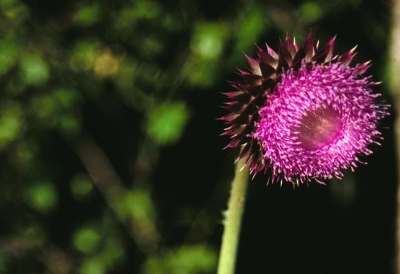Musk Thistle: The Linebacker of Weeds
Musk Thistle
Tall, athletic and handsome weed in search of rangeland, nature trails and scenic areas to call my own.
If weeds could place singles ads, musk thistle weed might pen the listing above. Growing to a full six feet and topped with a single purple bloom, the plant found its way onto the Colorado noxious weed list because it has no natural enemies to reduce its numbers. It’s known to encroach on pasture property, degrade wildlife habitats and block walking, running and biking trails.
Musk Thistle Weed Description
Musk thistle weed has a two-year growth cycle. In the first year, a rosette of leaves grows outward (about two feet in diameter), but close to the ground. Stalks and flowers appear in the second year and seeds are formed.
When the weed reaches its full height, its heavy flower heads (filled with up to 10,000 seeds, by the way) droop and seem to nod in the wind,
Because a dense stand of musk thistle creates a strong, fence-like barrier, rangeland and wildlife habitat is reduced and access to water is often limited to animals and humans alike.
Musk thistle will take over land, but it isn’t as competitive as most weeds. It reproduces entirely by seed (no root runners) and if healthy vegetation exists, growth is fairly contained. But its seeds remain viable for up to ten years, giving them plenty of time to be blown or carried to open spaces where they can set up housekeeping.
For more information about musk thistle weed and how to eliminate it, contact SprayTech, Colorado commercial and residential weed management experts, at 720-248-0000.


Comments are closed.